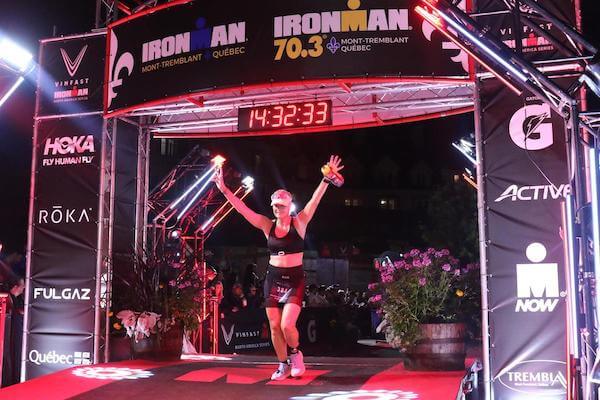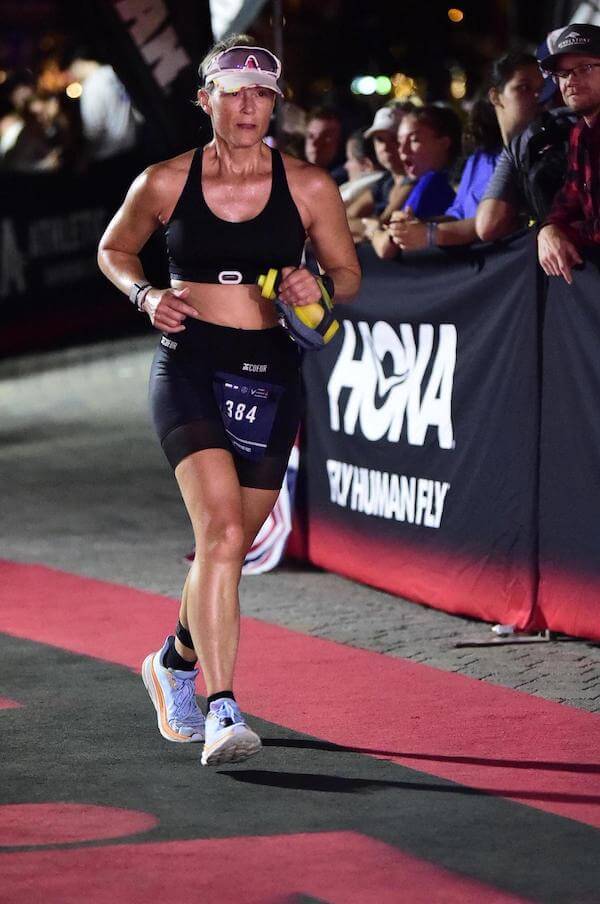Michelle Karalekas’ time in the Mont Tremblant Ironman Triathlon in Quebec on Aug. 20 — 14 hours, 5 minutes — was not her fastest in the grueling event, but it may have been her most impressive. It was the first time she’d competed since undergoing a stem cell transplant for acute myeloid leukemia (AML) almost three years earlier.
“This is my comeback year,” says the Hingham, Mass., resident, who received her transplant at the Dana-Farber Brigham Cancer Center in November 2020, the height of the COVID-19 pandemic.
It’s a comeback in keeping with the determination that first led her to train for Ironman competitions in 2017. A self-described non-athlete during her school years — she joined a sailing club in college specifically because it didn’t involve running — Karalekas began running in her late 30s to stay fit while she looked for a convenient health club. Later, a club fitness director asked if she’d like to join a triathlon training group he was forming.
“I can’t do it,” she recalls telling him. “I don’t have a bike.” (Full-distance Ironman events consist of a 2.4-mile swim, 112-mile bike, and 26.2-mile running race.) When a friend loaned her a bike, she thought, “Well, I don’t have an excuse now.”

Though training was demanding, the results came as a revelation to one who had once shunned sports. “With each week that went by, I was exhausted but I kept going.” Karalekas relates. “It was amazing that my body was willing to do whatever I told it to do.”
Karalekas competed at Mont Tremblant in 2017 and 2018, as well as some half-distance Ironman events in 2019. Early in 2020, though, she developed a low-grade fever and began experiencing abdominal pain. She was tested for COVID-19, but because it was early in the pandemic, the results weren’t available for 10 days. Meanwhile, the abdominal pains worsened. At her local hospital emergency room, she was diagnosed with diverticulitis — an inflammation of small pockets in the colon — but a blood test revealed blast cells, immature white blood cells that are often a sign of leukemia.
She was transferred by ambulance to Brigham and Women’s Hospital, where doctors confirmed the leukemia diagnosis and started her on the chemotherapy drug Vyxeos after a week-long course of antibiotics to treat her diverticulitis.
At Dana-Farber Brigham, doctors performed a bone marrow biopsy to identify the specific genetic mutations in her leukemia cells. Further tests showed that her sister was a perfect immunological match for Karalekas and could provide the donor stem cells for the transplant, which took place that November.
Karalekas didn’t experience any major complications from the procedure and, upon release from the hospital, gradually resumed exercising. “I didn’t want to lose too much of what I’d spent so much time gaining in terms of fitness,” she remarks.
All went well after the transplant, but a year later, after receiving a series of standard vaccines, she began experiencing myopathy — muscle weakness — possibly because her still-maturing immune system confused some of the proteins in in her muscles for proteins in the vaccines and launched an attack on the muscles.
“I was riding my bike and felt pain in my hip flexors [hip muscles],” Karalekas recalls. “Within a couple days, I had to use my arms to lift my leg to get into the car. A few days later, even rubbing lotion on my arms was almost impossible.”

Coming to Dana-Farber
Just before Thanksgiving, Karalekas came to Dana-Farber, where tests showed her creatine kinase levels — which can indicate muscle damage — were elevated far beyond normal. Her oncologist, Robert Soiffer, MD, chief of the Division of Hematologic Malignancies, prescribed prednisone to quell her overactive immune system and ordered a muscle biopsy.
“It wasn’t clear at first whether the myopathy was a reaction to the vaccines or whether it was graft-versus-host disease [or GVHD, which arises when transplanted stem cells attack a patient’s healthy tissue],” Karalekas says. Results of the biopsy indicated it was a bit of both.
Soiffer prescribed the anti-GVHD drug Jakafi, which alleviated the myopathy and allowed Karalekas to, once again, start building muscle strength. The two-steps-forward, one-step-back nature of her recovery didn’t deter her. “My body was used to being in shape,” she says. “I knew what it would take to regain fitness and what it would feel like.”
And although competing in an Ironman event wasn’t a definite goal, it remained in the back of her mind. “I remember thinking in 2021, ‘I wonder if I could do a race this year,'” she relates. The risk of infection from swimming in a lake deferred that possibility until this year when, with clearance from Soiffer, she made it a reality.
“Michelle has tremendous strength and perseverance,” Soiffer says. “Her approach to her transplant was similar to that for the Ironman event — determination and grit even in the face of significant obstacles. I am in awe of her.”

Wow! Congrats, Michelle!! Very inspirational – I had no idea I was working with an Ironman!!! Thanks for being such a great role model, at work and at play!!!
Thank you Mike!
So inspirational, keep going Michelle!
You’re an inspiration to oncology nurses Michelle!
Is this is the same Maressa that took care of me so well at Brighams? Thank you for all you do and did if so! All the nurses were so amazing and compassionate. You helped make my journey a success.
Maressa, Ann, Kathleen, Susan, Christine, Laura, Kristen, Betsy, Beth, Jeff, Kara, Nuela, Bridget, Amanda, Justine, Cynthia, Maria, Seanny, Roque, Solage, Elsivere, Raegan, Nicole, Kate, Carmen
Inspirational, Congratulations! Reminds me I better start getting back into shape after recently completing hormone & chemo therapy’s. Easy to just say I need some rest, smarter to say rest after some exercise even if it’s just baby steps I will still be moving forward. Appreciate you sharing your journey.
U are my hero, I had diverticulitis too in 2022 came down with AML was in hospital At AMC for 65 days than went to Dan-Farber had. a stem cell transplant Aug 26 so it’s been a year feeling better everyday I would like to thank my doctors there and of course the nurses I did all this as a outpatient took 30 days I live 3 hours away I stayed for the 30 days in hotel back an fourth everyday but u are awesome
You are an inspiration, Michelle! I had a stem cell transplant in June 2021 and you are inspiring me to push myself even more that my typical workouts and pickle ball! Great job! Linda